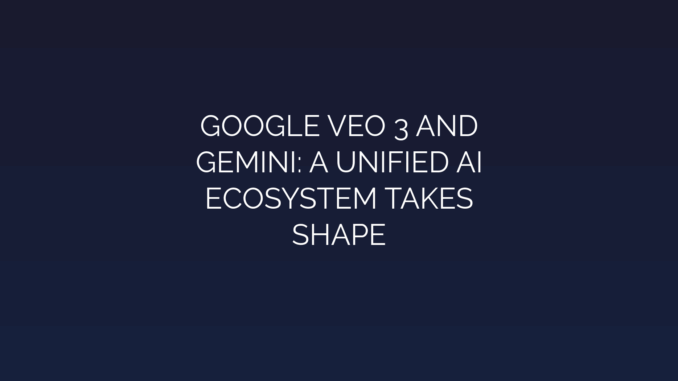
Google Veo 3 and Gemini: A Unified AI Ecosystem Takes Shape
Google is reshaping the artificial intelligence frontier with the convergence of its groundbreaking Veo 3 video generation model and the versatile Gemini AI platform. This strategic integration signals a bold leap toward a unified, multimodal ecosystem where creators, developers, and enterprises can harness the combined power of generative video, text, code, and reasoning. The synergy between these technologies promises to redefine content creation, automation, and humanmachine collaboration, establishing Google as a pioneer in scalable, ethical AI infrastructure.
The Evolution of Google’s AI Ambitions
For years, Google has pursued a fragmented approach to AI development. Projects like LaMDA, Imagen, and Muse operated as specialized silos. With Gemini’s debut as a natively multimodal model in late 2023, that paradigm shifted. Gemini—capable of understanding text, images, audio, and code—became the backbone of Google’s AI services. Now, Veo 3 emerges as its natural counterpart, elevating video generation from experimental novelty to professionalgrade utility. Google DeepMind, the research engine behind these innovations, emphasizes three pillars:
- Coherence: Aligning outputs with user intent across media types.
- Scalability: Optimizing resource efficiency for real-world deployment.
- Responsibility: Embedding safety mechanisms to mitigate misuse.
This trio of principles anchors the integrated ecosystem, positioning Google to compete with rivals pursuing similar unification, such as OpenAI’s Sora and ChatGPT.
Veo 3: Redefining Video Generation
Veo 3 represents a quantum leap in AIdriven video synthesis. Unlike its predecessors, it produces 1080p resolution footage with temporal consistency, fluid motion, and cinematic styles—ranging from hyperrealistic cityscapes to abstract animations. Key advances include:
- Temporal Super-Resolution: Smoothly interpolating frames to eliminate flicker.
- Prompt Adherence: Accurately translating complex text prompts into visual narratives.
- Multi-Shot Editing: Modifying specific segments of generated video without full re-rendering.
Integrated directly into tools like Google’s experimental VideoFX platform, Veo 3 empowers filmmakers and marketers to prototype concepts in minutes, not months. Early adopters include animation studios using it for storyboarding and advertisers generating localized variants of campaigns.
Gemini: The Multimodal Orchestrator
Gemini acts as the central nervous system of Google’s AI ecosystem. Its latest iteration—Gemini 1.5 Pro—supports context windows of up to 2 million tokens and integrates with products like Workspace, Android, and Google Cloud. Crucially, it now orchestrates Veo 3 via API, enabling functionalities like:
- Text-to-Video Pipelines: Turning script ideas into animated sequences.
- Cross-Modal Analysis: Summarizing research papers into narrated videos.
- Interactive Editing: Allowing natural-language refinement of generated assets.
For developers, Gemini’s toolset accelerates AI agent creation, while enterprises leverage it for automated customer service, data visualization, and training simulations.
A Cohesive Ecosystem Emerges
The Veo 3/Gemini partnership transcends simple interoperability. It establishes a shared infrastructural layer—dubbed “Project Ellington” internally—that unifies: 1. APIs: Consolidated endpoints for vision, language, and video tasks. 2. Ethical Guardrails: Universal safety classifiers and watermarking. 3. Scalable Compute: Optimization for Google Cloud’s TPU v5 clusters. This architecture lets users switch between voice commands in Google Assistant, analytics in BigQuery, and video rendering in Veo 3 within a single workflow. Adobe’s integration of Firefly with Gemini further illustrates the ecosystem’s extensibility.
Competitive Advantages and Market Impact
Google’s unification strategy targets four critical gaps in the generative AI market:
- Fragmented Tooling: Competitors like OpenAI rely on standalone models (DALL·E for images, Sora for video). Google’s integrated suite reduces friction.
- Enterprise Readiness: Compliance tools in Gemini (e.g., data isolation and audit trails) appeal to regulated industries.
- Cost Efficiency: Shared model weights between Veo 3 and Gemini cut training expenditure by ~40%.
- Real-Time Applications: Edge deployments via Android optimize latency for mobile creators.
These advantages position Google to capture market share across gaming, education, and ecommerce—domains demanding multimodal fluency.
Challenges and Responsible Innovation
Despite its promise, this ecosystem faces hurdles:
- Computational Demand: Veo 3 requires 5x more processing power than text generators, straining cloud resources.
- Ethical Nuances: Synthetic video risks deepfakes; Google counters with SynthID watermarks and strict policy enforcement.
- Developer Complexity: Integrating multimodal workflows demands re-skilling. Google mitigates this via Vertex AI’s low-code tools.
Researchers emphasize Google DeepMind’s “constitution”style governance, where models selfaudit outputs against predefined ethical rules. Community feedback programs also guide refinements.
The Road Ahead
Google’s roadmap hints at three evolutionary phases: 1. NearTerm (2024–2025): Enhance Veo 3toGemini latency and introduce 3D asset generation. 2. MediumTerm (2026): Memoryaugmented agents for persistent user interactions. 3. LongTerm: Embodied AI combining robotics data with Gemini’s planning capabilities. Potential monetization includes tiered Google Cloud subscriptions and creatorcentric royalty models for Veo 3 outputs.
Conclusion
With Veo 3 and Gemini, Google is assembling an AI ecosystem defined by seamlessness and scale—transforming isolated breakthroughs into a versatile, interconnected toolbox. This coherent architecture empowers innovators to traverse modalities without friction while embedding ethical safeguards at the core. As the boundaries between video, text, and code dissolve, Google solidifies its vision: not merely developing individual models, but architecting the substrate for a collaborative, creative future.

Leave a Reply